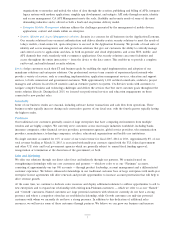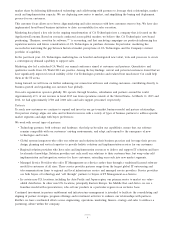Computer Associates 2015 Annual Report Download - page 20
Download and view the complete annual report
Please find page 20 of the 2015 Computer Associates annual report below. You can navigate through the pages in the report by either clicking on the pages listed below, or by using the keyword search tool below to find specific information within the annual report.
prevent and detect such incidents, we may be unable to anticipate these problems and such incidents could require
significant expenditures of our capital and diversion of our resources from development activities. Additionally, these efforts
by hackers or others could cause interruptions, delays or cessation of our product licensing, or modification of our software,
which could cause us to lose existing or potential customers. If these efforts are successful and a third party obtains
unauthorized access to our or our customers’ IT environments, our business operations, and those of our customers, could
be adversely affected, losses or theft of data could occur, our reputation and future sales could be harmed, governmental
regulatory action or private or governmental litigation could be commenced against us and our business, financial condition,
operating results and cash flow could be materially adversely affected.
If we do not adequately manage, evolve and protect our information systems, infrastructure and processes,
including the successful implementation of our enterprise resource planning software, our ability to manage
and grow our business may be harmed.
We rely on our information systems and information systems of third parties for managing the financial information of our
business. Any disruption in our information systems and those of the third parties upon whom we rely could have a
significant impact on our business. In addition, we continuously work to enhance our information systems and infrastructure.
The implementation of these types of enhancements, including the successful implementation of our enterprise resource
planning software, is frequently disruptive to the underlying business, which may especially be the case for us due to the size
and complexity of our business. Additionally, delays in adapting our information systems to address new business models,
such as SaaS, could limit the success or result in the failure of those initiatives and impair the effectiveness of our internal
controls. Although we have implemented a disaster recovery program, our system redundancy may be ineffective or
inadequate and our disaster recovery planning may not be sufficient for all eventualities. With regard to the implementation
of our enterprise resource planning software, any delay in the implementation of, or disruption in the transition to, our new
or enhanced systems, procedures or internal controls, could adversely affect our ability to accurately forecast sales demand,
manage our supply chain, achieve accuracy in the conversion of electronic data and records, and report financial and
management information, including the filing of our quarterly or annual reports with the SEC, on a timely and accurate
basis. Failure to properly or adequately address these issues, as well as to manage and protect our infrastructure, could
result in the diversion of management’s attention and resources, adversely affect our ability to manage our business,
including our SaaS business, and to meet our obligations to our customers, and materially adversely affect our business,
financial condition, results of operations and cash flow. Refer to Item 9A, ‘‘Controls and Procedures,’’ for additional
information.
Fluctuations in foreign exchange rates could result in losses.
Our consolidated financial results are reported in U.S. dollars. Most of the revenue and expenses of our foreign subsidiaries
are denominated in local currencies. Given that cash is typically received over an extended period of time for many of our
license agreements and given that a substantial portion of our revenue is generated outside of the United States,
fluctuations in foreign exchange rates (such as the euro) against the U.S. dollar could result in substantial changes in
reported revenues and operating results due to the foreign exchange impact upon translation of these transactions into U.S.
dollars.
In the normal course of business, we employ various hedging strategies to partially mitigate these risks, including the use of
derivative instruments. These strategies may not be effective in protecting us against the effects of fluctuations from
movements in foreign exchange rates. Fluctuations of the foreign exchange rates could materially adversely affect our
business, financial condition, operating results and cash flow.
Discovery of errors or omissions in our software products could materially adversely affect our revenue and
earnings and subject us to costly and time consuming product liability claims.
The software products we offer are inherently complex. Despite testing and quality control, we cannot be certain that errors
or omissions will not be found in current versions, new versions, documentation or enhancements of our software products
(collectively, our Products) after commencement of commercial shipments. If new or existing customers have difficulty
deploying our Products or require significant amounts of customer support, our operating margins could be adversely
affected. We could also face possible claims and higher development costs if our Products contain errors that we have not
detected or if our Products otherwise fail to meet our customers’ expectations. Significant technical challenges also arise
with our Products because our customers license and deploy our Products across a variety of computer platforms and
integrate them with a number of third-party software applications and databases. These combinations increase our risk
17
























